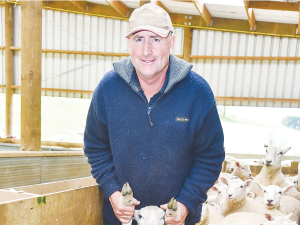Breeder credits late uncle for hair sheep success
Southland breeder Tim Gow attributes the success of his Shire breed of hair sheep to the expert guidance of his uncle, the late Dr Scott Dolling, who was a prominent Australian animal geneticist.
 Waimate farmer Tim Mehrtens says he has been pleasantly surprised at the Wiltshire's mothering ability and pre-weaning growth rates.
Waimate farmer Tim Mehrtens says he has been pleasantly surprised at the Wiltshire's mothering ability and pre-weaning growth rates.
Continuing poor returns for crossbred wool coupled with the emergence of triple drench resistance is driving an increasing number of sheep farmers to consider making the shift to low-input, no-shear Wiltshires.
Aside from shearing, the costs of crutching, dagging and flystrike are all eliminated with these shedding sheep. Meanwhile, Wiltshires are said to be more resistant and resilient to internal parasites than their wooly counterparts.
Will Pears, stud manager at North Canterbury's Mt Cass Wiltshire stud, says last year's inaugural sale exceeded all expectations in terms of price and interest. He is expecting the same at this year's sale on January 19.
Pears says last year more than 100 buyers from around the country competed strongly for both rams and ewes and feedback from purchasers has been overwhelmingly positive.
One of those buyers was Waimate farmer Tim Mehrtens. He admits it took a leap of faith in buying Wiltshire ewe lambs and rams at the Mt Cass's sale but was rewarded with a good lambing percentage and very good pre-weaning growth rates.
Mehrtens, who farms 215ha of rolling hill country, says the shift to Wiltshire genetics was driven by frustration with poor returns for wool. While he has been buying very good composite ewe lambs, in 2020 the difference between shearing costs and the wool cheque left him $3,500 out of pocket.
The first crop of pure Wiltshire and Wiltshire cross lambs, born last spring, exceeded expectations. Mehrtens says he was pleasantly surprised at the pre-weaning growth rates and their mothering ability.
Forced to wean early due to limited processing space, he says 220 twin male lambs killed out at 17.5 kgCW and a line of Wiltshire cross lambs averaged 17.7 kgCW.
Mehrtens has also noticed that a lot of the first cross lambs have started to shed.
"I'm stoked with the results," he says.
A New Zealand dairy industry leader believes the free trade deal announced with India delivers wins for the sector.
The Coalition Government will need the support of at least one opposition party to ratify the free trade deal with India.
Primary sector leaders have welcomed the announcement of a Free Trade Agreement between India and New Zealand.
At Pāmu’s Kepler Farm in Manapouri, mating has wrapped up at the across-breed Beef Progeny Test.
More than 150 people turned up at Parliament recently to celebrate the 20th anniversary of Horticulture New Zealand (HortNZ).
Biosecurity New Zealand says Kiwis should continue to keep an eye out for yellow-legged hornets (Vespa velutina) over the holiday season.

OPINION: The release of the Natural Environment Bill and Planning Bill to replace the Resource Management Act is a red-letter day…
OPINION: Federated Farmers has launched a new campaign, swapping ‘The Twelve Days of Christmas’ for ‘The Twelve Pests of Christmas’ to…